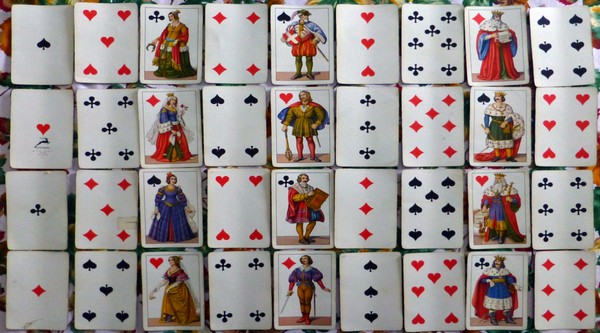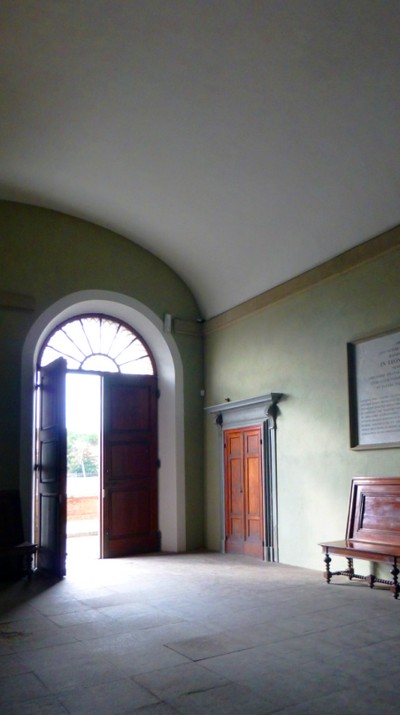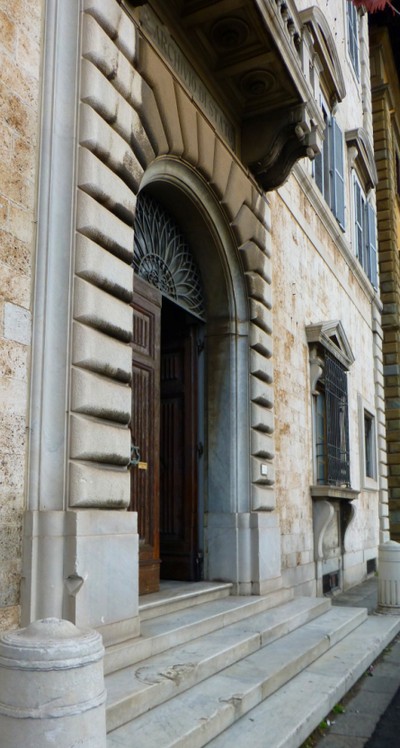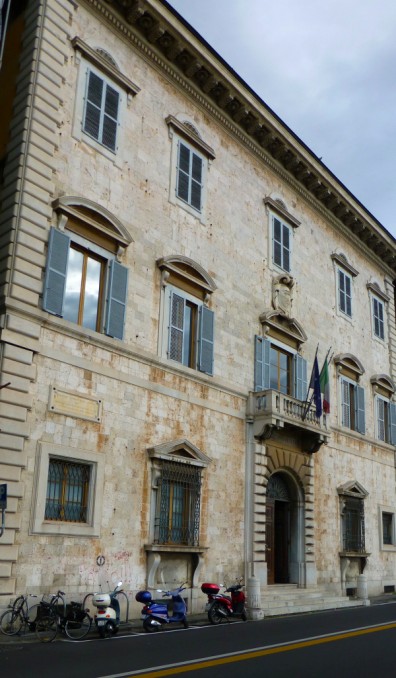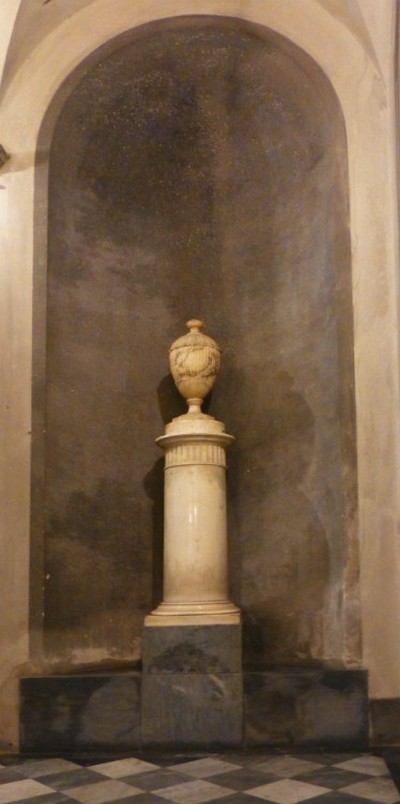Introduction
Recently, I have included Pisa in my research, and in particular the local section of Archivio di Stato (ASPI).(1) If one thinks of Pisa, the Piazza dei Miracoli comes at once to the mind. In our field, more than the Leaning Tower, it would be the Campo Santo and its frescoes to convey some inspiration to tarot fans. For the moment, I can only describe a more recent item, my first finding after a few visits, which involves a 36-card pack of the 18th century, and how it seems to have been used.
The Archivio dello Stato di Pisa (ASPI)
The ASPI occupies a beautiful Palace, as often occurs for such institutes. Palazzo Toscanelli is placed on the right bank of the Arno river - photos of its façade and entrance are shown. I had already visited it during my researches of twenty years ago, without any useful result. Now, I have more sections to examine there, and in particular all those of the Eredità kind, which I did not investigate at the time.
Several sections of Eredità exist in the ASPI, and in particular in the collections of Pia Casa della Misericordia, Pia Casa della Carità, and Ospedali Riuniti di Santa Chiara.(2) As usual, they mostly correspond to the 17th century or later on, and the account books of the 15th century of possible interest are few. I have already examined a remarkable fraction of them now, without finding any mention of playing cards, even where finding them could reasonably be expected.
From the Inventory
The document under examination can be found in the collection Miscellanea Manoscritti, which is one of the few ones with an Inventory available on-line.(3) The name itself of the collection clearly indicates its character, a combination of manuscripts of various kind and provenance; it would be hopeless to search guidelines for explaining their selection. There are books of poetry, religion, history, and of any other cultural sector of the past, for several centuries.
In correspondence with No. 100, we read in the Inventory:
100. Busta contenente i seguenti documenti: XVIII s.
- Origine del Giuoco del Ponte in Pisa e sue battaglie numerate. 34 cc. XVIII s.
- “ Orazzioni nella messa per la Benedizione delle Bandiere nel Giuco del Ponte fatte dal Padre Maestro Teologo Berti ….. “ 1785
- Appunte rigurdanti un gioco di carte, XVIII s.
- Repertorio dei Documenti, Memorie ecc. della Biblioteca Zucchelliana, cc. 9.
|
Clearly, my interest was focused on document No. 3 contained in this folder, “Notes concerning a card game”.
Antecedents
Let me first explain why I had not examined this promising document already, during my recent visits in the ASPI. My study of the history of playing cards follows a previous study of the history of chess, and this means that my interest in playing cards is basically aimed to “intelligent” games, to be played as pastimes within the family or between friends. Differently from chess, however, playing cards may be used for further aims, gambling to begin with, but also for conjuring, divination, or for building houses of cards.
In my past experience of card research, I have been often disappointed in finding new promising items registered in the catalogues under the name of “Giochi di carte”, as in the present case. In the Italian language, this cannot be understood as card packs; its current meaning is for card games, as Tressette, Briscola, Scopa, or other customary games. I thus have hoped several times that at long last I had found a booklet with the laws of some of the many card games mentioned in the last centuries; for most of them we know the name and nothing else.
With no exception, my new findings of this kind “only” were collections of conjuring tricks performed with playing cards. In a few cases, I decided that what I had found was worth reporting.(4) I know that experts exist who are interested just in this sector, and Thierry Depaulis recently reminded me that one finds the best lovers of playing cards, considered as precious objects for collecting, precisely among these experts. I was however disappointed in finding old documents on this sole aspect of the history of card games.
Now, on the basis of past experience, I was almost certain that the “Appunte riguardanti Giochi di carte” in Pisa were descriptions of conjuring tricks, of limited interest to me; therefore, only after some visits in the ASPI I decided to examine the sole document on playing cards mentioned in the catalogues.
The original document
In my last visit in the ASPI, I finally decided to examine the book; as I expected, the document was of the kind of the conjuring tricks, at least with a high probability. These Appunti, or notes, however, had the unexpected aspect of just a slip of paper of 21x10,5 cm, with a Table drawn on it, without any further explanation or description.
It is outlined below with abbreviated names. The suits, indicated with their initial capital letter, are Picche, Quori (a wrong spelling for Cuori), Fiori, and Mattoni. The court cards, Re, Dama and Fante, are indicated by their initial letter; A indicates Asso, ace.
In order to make the visualisation of these cards easier, I add a photo of the same thirty-six elements, represented by the corresponding set of Florentine playing cards. I apologise not to have used for this aim cards of the 18th century, but such a pack was not available to me.
|
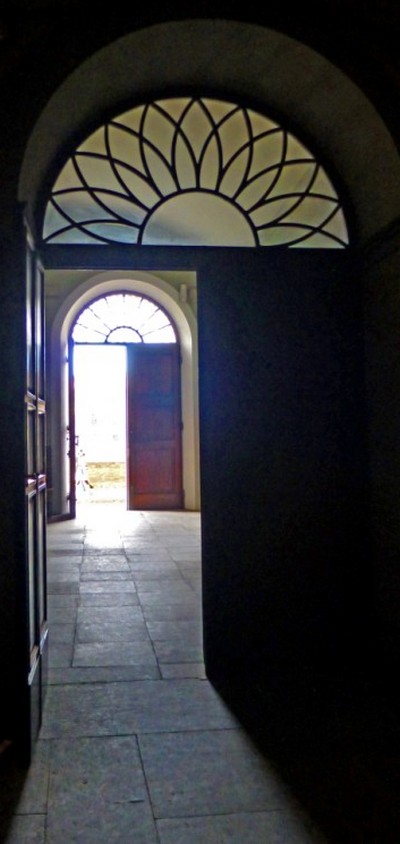
ASPI in Pisa, inside

|
|
Layout
There are some evident rules in the layout of the Table above. First is of course that in any column we find cards with identical value; these columns, however, are not ordered in a regularly increasing or decreasing way according to card values. If we list in order the number of the columns for increasing values of the cards, the series would appear as: 1; 6, 4, 2; 9, 7, 5, 3; 8. Within this series we can at most see three decreasing even numbers, followed by four decreasing odd numbers.
An additional regularity can be found in the succession of the suits. They clearly appear to be ordered according to diagonal lines, drawn from top right to bottom left. Thus, we find Picche in the line 9, 17, 25, 33; Mattoni in 8, 16, 24,32; Fiori in 7, 15, 23, 31; Quori in 6, 14, 22,30, and so on, continuing with Picche, Mattoni, Fiori and Quori again.
Let us now distinguish just between red and black suits. Each internal card is surrounded in the direction of the cardinal points by four cards of the other colour, and diagonally by further four ones, of the colour of the internal card. If we draw diagonal lines in the direction contrary to the previous one, namely from top left to bottom right, we find all black or all red cards, with two alternating suits, of the same colour.
Discussion
The name of the suits are typical of the Florentine cards. Worth noting may be Mattoni, bricks, preferred for Diamonds to the alternative Quadri or Denari, the latter historically linked with the original Coin suit of the Italian pattern. The most unexpected is however the suit Quori, a name which, just owing to its spelling, cannot be found in any dictionary.
Whether a given word containing the sound “ku” must be written in Italian as “qu” or “cu” is here a basic matter of the primary school, and writing Quori is not allowed to any school pupil. The person who wrote this Table shows a great dose of bravery, or of illiteracy.
Dama for Queen is on its turn a common way to indicate this card, probably the most used one (Donna being instead mostly applied to the chess queen). There are no further cases of names or card numbers to comment on, except for the missing 2s. It is unknown to me if this could be a complete pack of the time, with thirty-six cards.
What I know is that when I was a child, a few years later on, the common Florentine pack did not contain the 8s, 9s and 10s, as shown here, but it did contain the four 2s. If however the same 40-card pack was used at the time of this document, I do not see the reason why the four 2s had been removed from the pack.
The other documents in the same folder certainly belong to the 18th century, and thus I have no reason to turn down the attribution to the same century of the document under examination; I would just prefer its last quarter – sorry to say, I am not able to give a more precise date for it.
Conclusion
A new piece of evidence on the use of playing cards in Pisa in the 18th century has been described and briefly discussed. With a high probability, it belongs to the sector of conjuring tricks: a card pack with its elements distributed according to the “rule” indicated in the Table discussed above would of course allow to identify any single card missing in the set.
The particular layout of these cards may suggest an alternative handling, as a kind of puzzle, with the task to position the cards in a way that satisfies together a lot of conditions on their values, suits, and colours.
Footnotes:
(1) Archivio di Stato di Pisa ; Wikipedia.it: Palazzo Toscanelli
(2) Archivio di Stato di Pisa / (content)
(3) Archivio di Stato di Pisa / Miscellanea Manoscritti
(4) Playing-Card World, No. 50 (1987) 23-24, see: Ancient Card Tricks with Minchiate ; L’As de Trèfle, N. 45 (1991) 8-9¸ L’Esopo, N. 50 (1991) 67-76.
|
|

